Gelling Behavior of PAM/Phenolic Crosslinked Gel and Its Profile Control in a Low-Temperature and High-Salinity Reservoir
Abstract
:1. Introduction
2. Results and Discussion
2.1. Preparation of PHRO Gel
2.1.1. Process of Crosslinking
- HMTA is hydrolyzed to produce formaldehyde, which is crosslinked with PAM;
- Formaldehyde reacts with RO to generate polyhydroxy methyl phenol, which is crosslinked with PAM;
- Formaldehyde reacts with RO to phenolic resin, which is crosslinked with PAM.
2.1.2. Macroscopic and Microscopic Morphology of Gel
2.2. Effect of Additive Concentration on Gelling Performance of PHRO Gel
2.2.1. Effect of PAM Concentration on Gelling Performance
2.2.2. Effect of HMTA Concentration on Gelling Performance
2.2.3. Effect of RO Concentration on Gelling Performance
2.2.4. Effect of OA Concentration on Gelling Performance
2.3. The Effect of Aqueous Salinity on Gelling Performance of PHRO Gel
2.3.1. Gelling Performance in Monovalent Salt Solution
2.3.2. Gelling Performance in Divalent Salt Solutions
2.4. Plugging Performance
2.5. Discussion
3. Conclusions
- (1)
- PHRO can form gels with high strength and good stability at a low temperature. The optimal concentrations of different additives were PAM ≥ 0.4 wt%, HMTA≥ 0.5 wt%, RO ≥ 0.05 wt% and OA ≤ 0.3 wt%. The strength of the gel can reach the “G” grade. The gelation time is 105–173 h, and the dehydration rate is 2.1–5.2%.
- (2)
- The strength of PHRO gels in different concentrations of NaCl and KCl solutions can reach the “G” level, and the dehydration rate is 4.1–6.1%. The gelatinization time is 84–131 h, and it decreases with the increase in saline ion concentration. Furthermore, the strength of PHRO gels in different concentrations of CaCl2 and MgCl2 solutions can be maintained at the “G” level, and the dehydration rate is 4.1–8.6%. The gelatinization time is 115–143 h, and it decreases with the increase in saline ion concentration.
- (3)
- PHRO gel has a robust “stem-leaf” three-dimensional network structure, which contains embedded phenolic resin with different sizes and different molecular weights. It can enhance the strength of the PAM skeleton and improve the stability of the gel. Moreover, the PHRO gel still has a complete network structure in a high-concentration salt solution, the network is more compact due to mesh contraction, and the gel structure still has high strength.
- (4)
- The plugging rate of PHRO in simulated formation water is more than 97.6%, which is suitable for conformance control in low-temperature and high-salinity reservoirs.
- (5)
- The salt-resistant performance of PHRO gel is mainly because the phenolic resin generated by the fluid can strengthen the gel network structure, and OA has the function of shielding salt ions. The appropriate number of saline ions is beneficial for accelerating the crosslinking reaction and improving the gel strength. The results show that PHRO gel is suitable for in-depth conformance control in low-temperature and high-salinity formation, which has broad application prospects.
4. Materials and Methods
4.1. Materials
4.1.1. Additives
4.1.2. Simulated Formation Water
4.2. Methods
4.2.1. Preparation of PHRO Gel
4.2.2. Determination of Gelation Time and Gel Strength
4.2.3. Stability of PHRO Gel
4.2.4. Plugging Performance of PHRO Gel
4.2.5. The Microscopic Morphology of PHRO Gel
Author Contributions
Funding
Institutional Review Board Statement
Informed Consent Statement
Data Availability Statement
Conflicts of Interest
References
- Cheng, H.; Zheng, X.; Wu, Y.; Zhang, J.; Zhao, X.; Li, C. Experimental and numerical investigation on oil displacement mechanism of weak gel in waterflood reservoirs. Gels 2022, 8, 309. [Google Scholar] [CrossRef] [PubMed]
- Xiong, C.; Tang, X. Technologies of water shut-off and profile control: An overview. Pet. Explor. Dev. 2007, 34, 83–88. [Google Scholar]
- Zhen, N.; Dong, B.; Xia, B.; Zheng, X.; Xie, C. New cementing technologies successfully solved the problems in shallow gas, low temperature and easy leakage formations. In Proceedings of the International Oil and Gas Conference and Exhibition in China, Beijing, China, 8–10 June 2010. [Google Scholar]
- Aladasani, A.; Bai, B. Recent developments and updated screening criteria of enhanced oil recovery techniques. In Proceedings of the International Oil and Gas Conference and Exhibition in China, Beijing, China, 8–10 June 2010. [Google Scholar]
- Zhao, G.; You, Q.; Tao, J.; Gu, C.; Aziz, H.; Ma, L.; Dai, C. Preparation and application of a novel phenolic resin dispersed particle gel for in-depth profile control in low permeability reservoirs. J. Pet. Sci. Eng. 2018, 161, 703–714. [Google Scholar] [CrossRef]
- Bai, B.; Wei, M.; Liu, Y. Injecting large volumes of preformed particle gel for water conformance control. Oil Gas Sci. Technol. 2012, 67, 941–952. [Google Scholar] [CrossRef]
- Yao, C.; Lei, G.; Hou, J.; Xu, X.; Wang, D.; Steenhuis, T.S. Enhanced oil recovery using micron-size polyacrylamide elastic microspheres: Underlying mechanisms and displacement experiments. Ind. Eng. Chem. Res. 2015, 54, 10925–10934. [Google Scholar] [CrossRef]
- Imqam, A.; Bai, B. Optimizing the strength and size of preformed particle gels for better conformance control treatment. Fuel 2015, 148, 178–185. [Google Scholar] [CrossRef] [Green Version]
- Goudarzi, A.; Zhang, H.; Varavei, A.; Taksaudom, P.; Hu, Y.; Delshad, M.; Bai, B.; Sepehrnoori, K. A laboratory and simulation study of preformed particle gels for water conformance control. Fuel 2015, 140, 502–513. [Google Scholar] [CrossRef]
- Dai, C.; Zhao, G.; Zhao, M.; You, Q. Preparation of dispersed particle gel (DPG) through a simple high speed shearing method. Molecules 2012, 17, 14484–14489. [Google Scholar] [CrossRef]
- Qing, Y.; Yefei, W.; Zhou, W.; Ziyuan, Q.; Fulin, Z. Study and application of gelled foam for in-depth water shutoff in a fractured oil reservoir. J. Can. Pet. Technol. 2009, 48, 51–55. [Google Scholar] [CrossRef]
- Li, Y.; Li, Y.; Peng, Y.; Yu, Y. Water shutoff and profile control in china over 60 years. Oil Drill. Prod. Technol. 2019, 41, 773–787. [Google Scholar]
- Liang, J.-T.; Sun, H.; Seright, R. Why Do Gels Reduce Water Permeability More Than Oil Permeability? SPE Reserv. Eng. 1995, 10, 282–286. [Google Scholar] [CrossRef] [Green Version]
- Rozhkova, Y.A.; Burin, D.A.; Galkin, S.V.; Yang, H. Review of microgels for enhanced oil recovery: Properties and cases of application. Gels 2022, 8, 112. [Google Scholar] [CrossRef] [PubMed]
- Yu, H.; Ma, Z.; Tang, L.; Li, Y.; Shao, X.; Tian, Y.; Qian, J.; Fu, J.; Li, D.; Wang, L.; et al. The effect of shear rate on dynamic gelation of phenol formaldehyde resin gel in porous media. Gels 2022, 8, 185. [Google Scholar] [CrossRef]
- Ren, H.; Qu, N.; Wang, Y.; Qiu, X.; Liu, Q.; Chi, P. Effect of crosslinker concentration on the comprehensive properties of polyacrylamide-aluminium citrate/water glass gel. IOP Conf. Ser. Earth Environ. Sci. 2020, 440, 022021. [Google Scholar] [CrossRef]
- Tokar, E.; Tutov, M.; Kozlov, P.; Slobodyuk, A.; Egorin, A. Effect of the resorcinol/formaldehyde ratio and the temperature of the Resorcinol–Formaldehyde gel solidification on the chemical stability and sorption characteristics of ion-exchange resins. Gels 2021, 7, 239. [Google Scholar] [CrossRef]
- Zhang, C.; Qu, G.; Song, G. Formulation development of high strength gel system and evaluation on profile control performance for high salinity and low permeability fractured reservoir. Int. J. Anal. Chem. 2017, 2017, 2319457. [Google Scholar] [CrossRef]
- Du, D.; Pu, W.; Tan, X.; Liu, R. Experimental study of secondary crosslinking core-shell hyperbranched associative polymer gel and its profile control performance in low-temperature fractured conglomerate reservoir. J. Pet. Sci. Eng. 2019, 179, 912–920. [Google Scholar] [CrossRef]
- El-Karsani, K.S.; Al-Muntasheri, G.A.; Hussein, I.A. Polymer systems for water shutoff and profile modification: A review over the last decade. SPE J. 2013, 19, 135–149. [Google Scholar] [CrossRef]
- Zhao, G.; Dai, C.; Chen, A.; Yan, Z.; Zhao, M. Experimental study and application of gels formed by nonionic polyacrylamide and phenolic resin for in-depth profile control. J. Pet. Sci. Eng. 2015, 135, 552–560. [Google Scholar] [CrossRef]
- Fang, Y.; Yang, E.; Cui, X. Study on profile control and water shut-off performance of interpenetrating network polymer gel composite system in shallow low temperature fractured oil layer. ChemistrySelect 2019, 4, 8158–8164. [Google Scholar] [CrossRef]
- Zhang, L.; Khan, N.; Pu, C. A new method of plugging the fracture to enhance oil production for fractured oil reservoir using gel particles and the HPAM/Cr(3+) system. Polymers 2019, 11, 446. [Google Scholar] [CrossRef] [PubMed] [Green Version]
- DiGiacomo, P.M.; Schramm, C.M. Mechanism of polyacrylamide gel syneresis determined by C-13 NMR. In Proceedings of the SPE Oilfield and Geothermal Chemistry Symposium, Denver, CO, USA, 1–3 June 1983. [Google Scholar]
- Wang, D. Study on mechanism of Ca2+ on the syneresis of HPAM gel. Sci. Technol. Eng. 2017, 17, 277–281, 287. [Google Scholar]
- Kizilay, M.Y.; Okay, O. Effect of hydrolysis on spatial inhomogeneity in poly(acrylamide) gels of various crosslink densities. Polymer 2003, 44, 5239–5250. [Google Scholar] [CrossRef]
- Bueno, V.B.; Bentini, R.; Catalani, L.H.; Petri, D.F.S. Synthesis and swelling behavior of xanthan-based hydrogels. Carbohydr. Polym. 2013, 92, 1091–1099. [Google Scholar] [CrossRef] [Green Version]
- Muta, H.; Kojima, R.; Kawauchi, S.; Tachibana, A.; Satoh, M. Ion-specificity for hydrogen-bonding hydration of polymer: An approach by ab initio molecular orbital calculations. J. Mol. Struct. THEOCHEM 2001, 536, 219–226. [Google Scholar] [CrossRef]
- Pu, J.; Geng, J.; Han, P.; Bai, B. Preparation and salt-insensitive behavior study of swellable, Cr3+-embedded microgels for water management. J. Mol. Liq. 2019, 273, 551–558. [Google Scholar] [CrossRef]
- Jia, H.; Pu, W.-F.; Zhao, J.-Z.; Liao, R. Experimental investigation of the novel phenol−formaldehyde cross-linking HPAM gel system: Based on the secondary cross-linking method of organic cross-linkers and its gelation performance study after flowing through porous media. Energy Fuels 2011, 25, 727–736. [Google Scholar] [CrossRef]
- Sydansk, R.D. Delayed in Situ Crosslinking of Acrylamide Polymers for Oil Recovery Applications in High-Temperature Formations. U.S. Patent 4844168A, 4 July 1989. [Google Scholar]

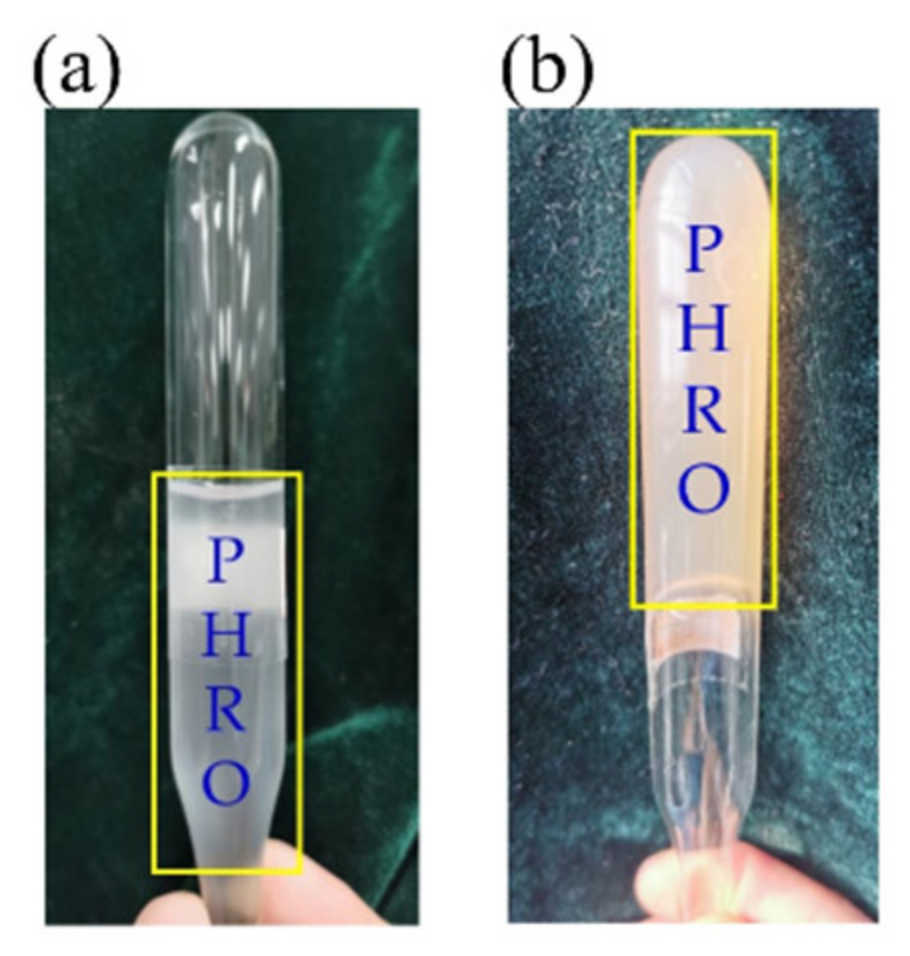
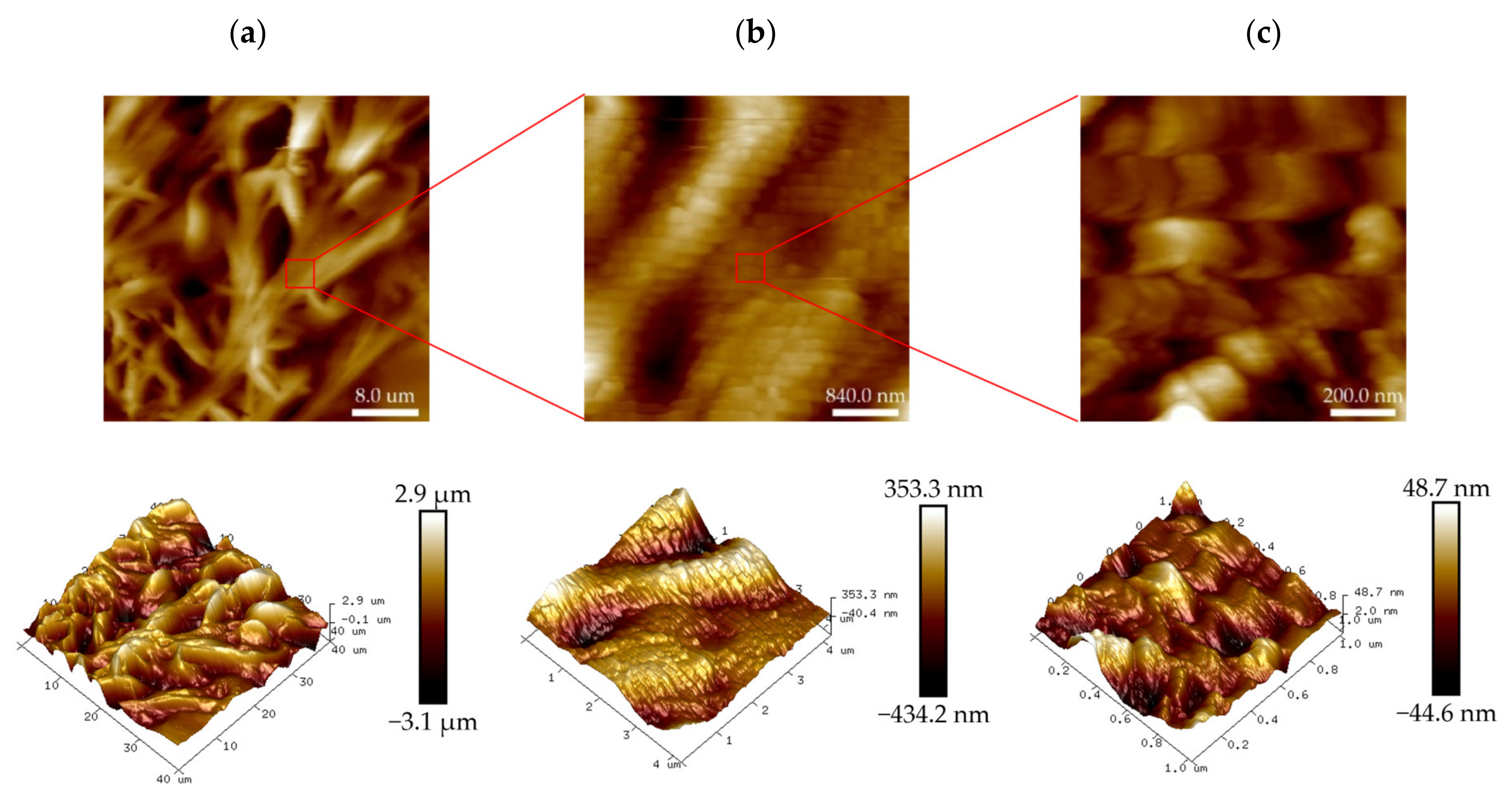
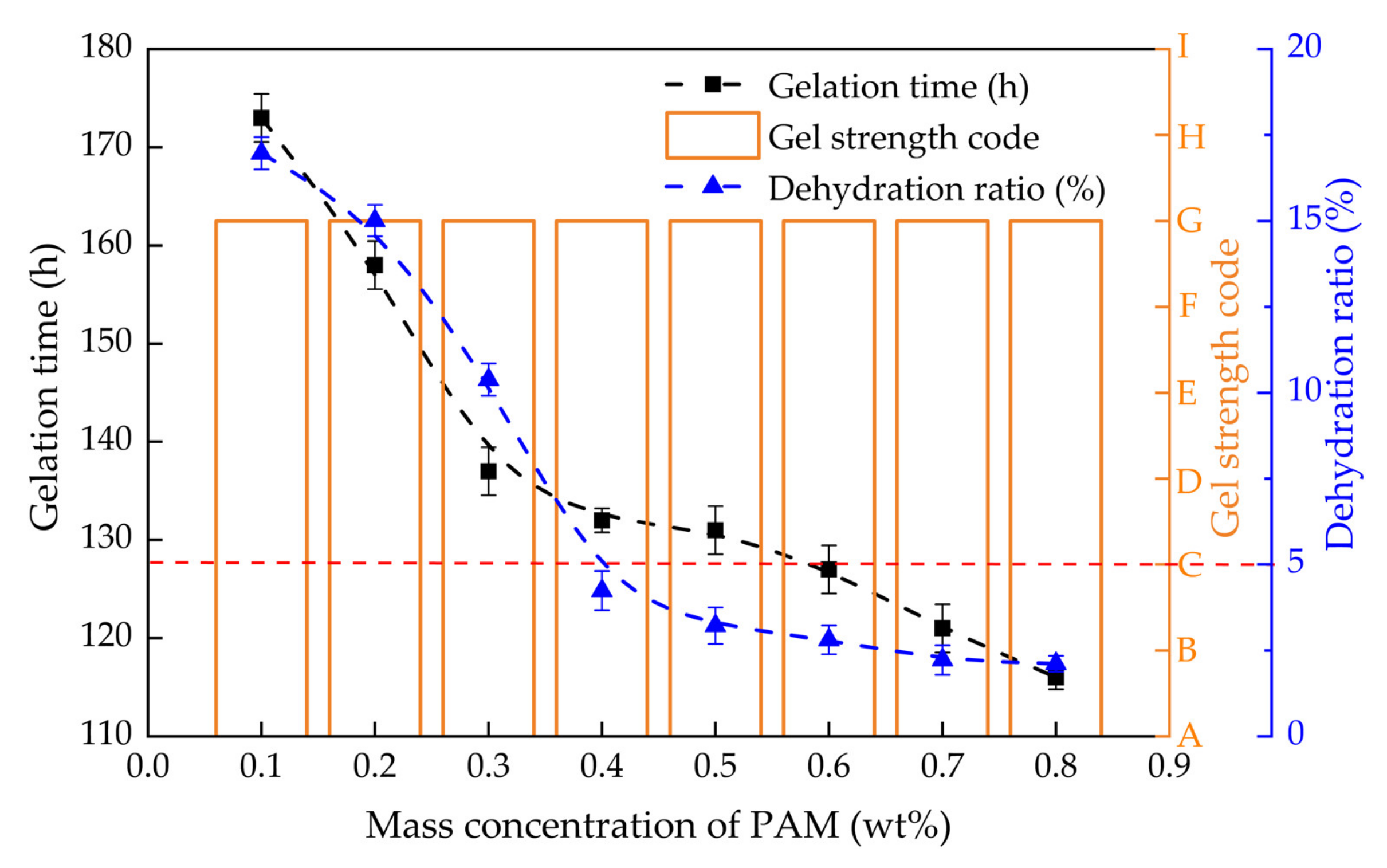
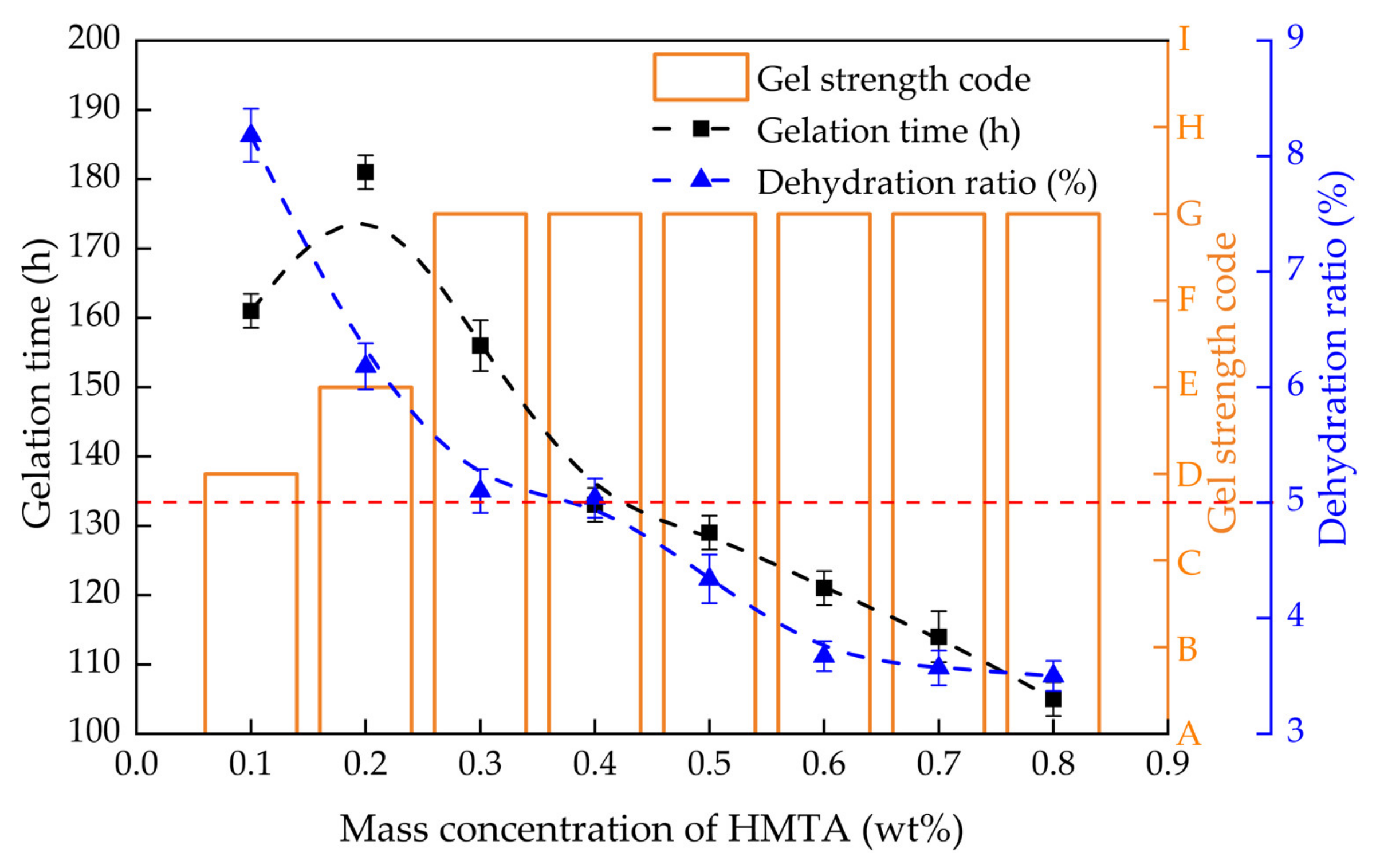

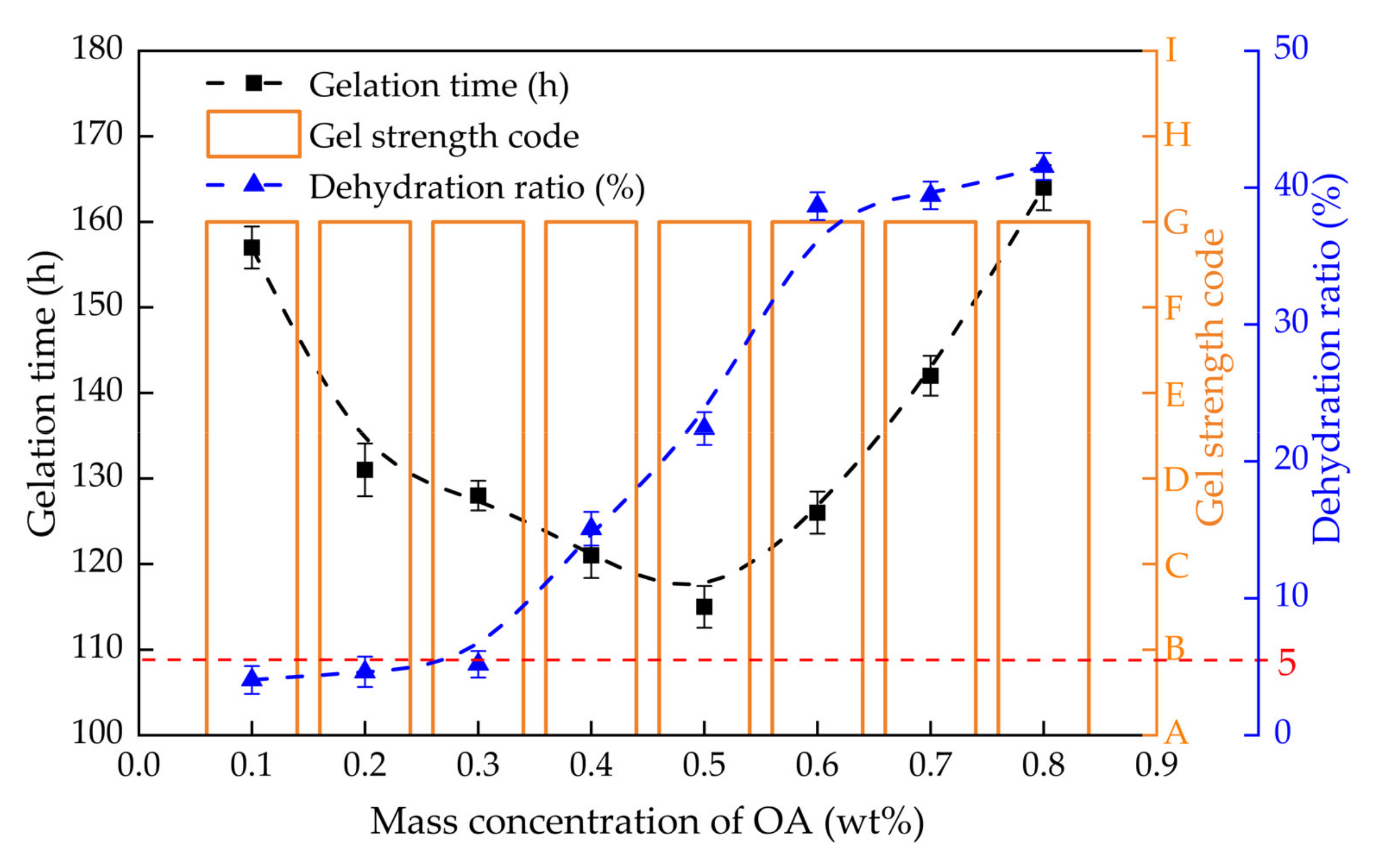

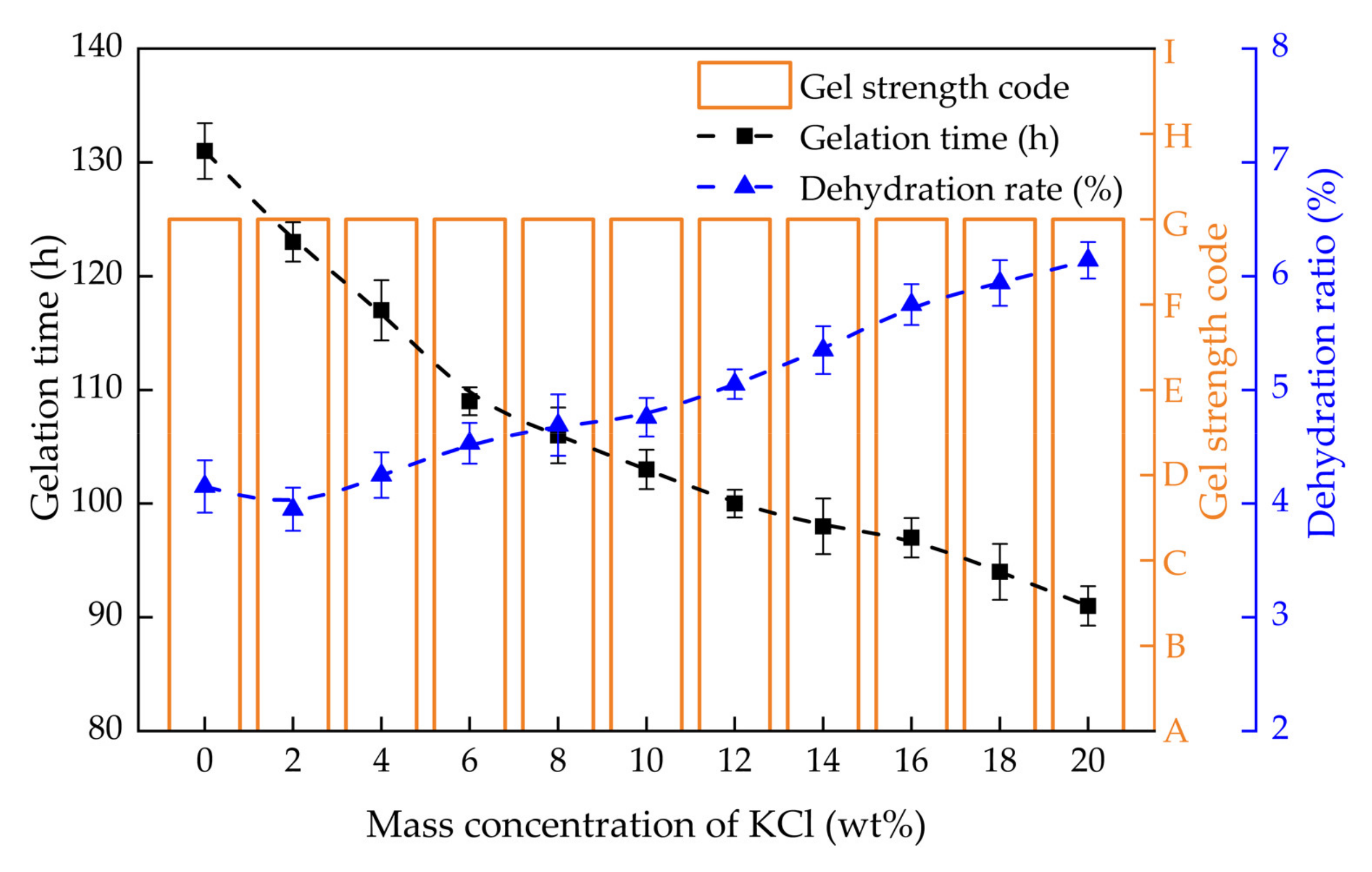
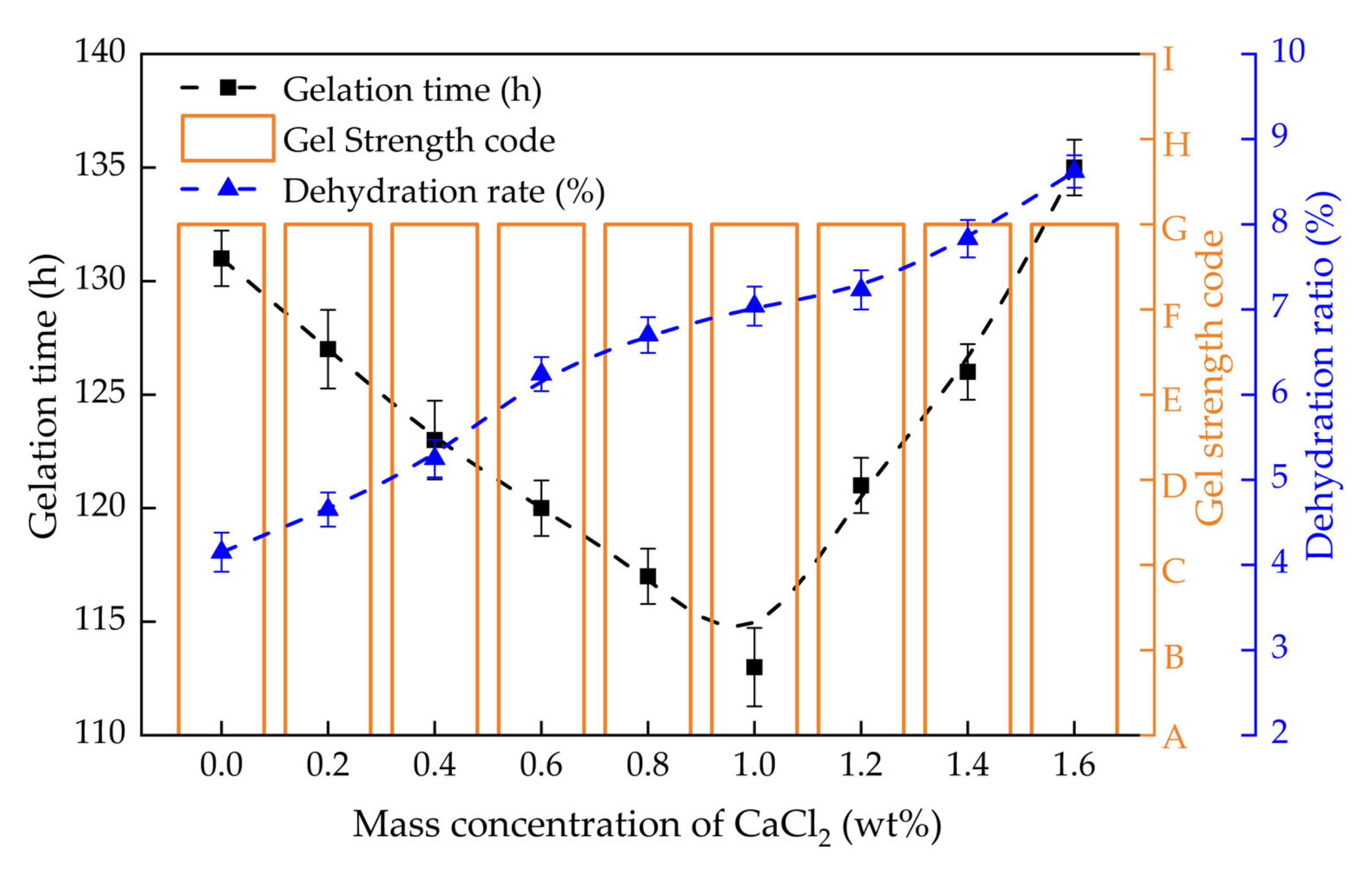
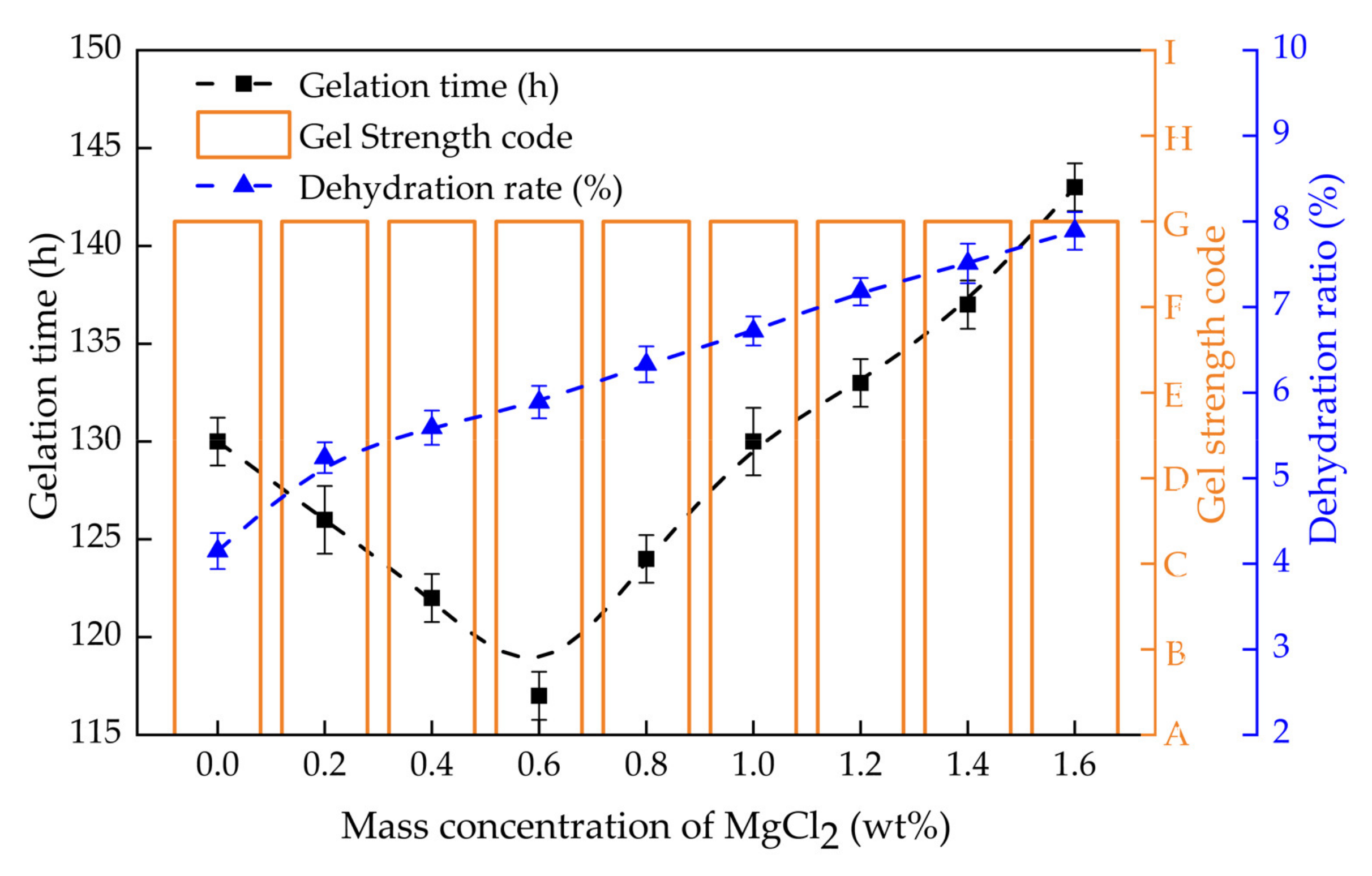




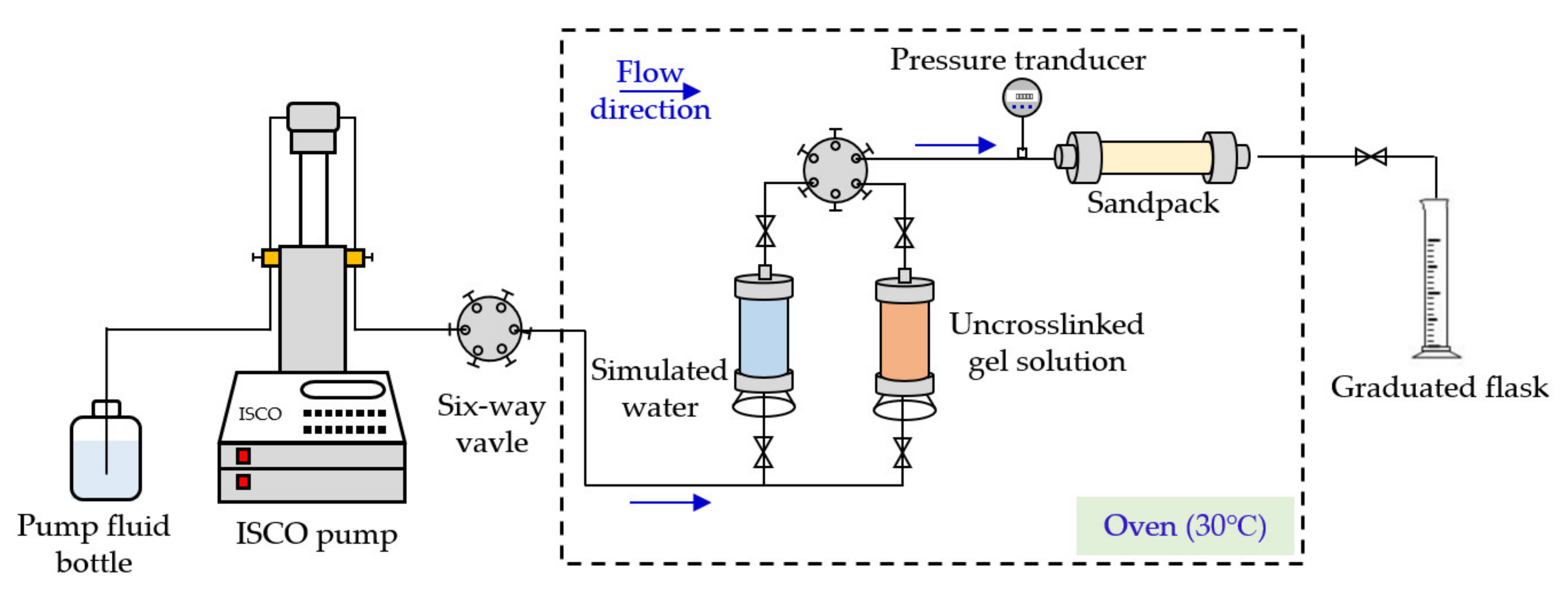
| Number of Sandpack | E (%) | |||
|---|---|---|---|---|
| SC-1 | 6.13 | 251.6 | 41.0 | 97.6 |
| SC-2 | 4.23 | 238.2 | 56.3 | 98. 2 |
| SC-3 | 3.31 | 216.8 | 62.5 | 98.5 |
| Ionic Type | Cl− | SO42− | HCO3− | Mg2+ | Ca2+ | Na+ | K+ |
|---|---|---|---|---|---|---|---|
| Ionic content (mg/L) | 36879.4 | 540.9 | 72.6 | 579.3 | 1985 | 17445.9 | 5743.1 |
| Gel Strength Code | Gel Category | Gel Description |
|---|---|---|
| A | No detectable gel | The same viscosity as the original polymer solution. |
| B | Highly flowing gel | Only slightly more viscous than the initial polymer solution. |
| C | Flowing gel | Most of the gel flows to the bottle cap by gravity upon inversion. |
| D | Moderately flowing gel | Only a small portion (5.0–10.0%) of the gel does not readily flow to the bottle cap by gravity upon inversion |
| E | Barely flowing gel | Significant portion (>15.0%) of the gel does not flow by gravity upon inversion. |
| F | Highly deformable non-flowing gel | The gel does not flow to the bottle cap by gravity upon inversion. |
| G | Moderately deformable non-flowing gel | The gel deforms about halfway down the bottle by gravity upon inversion. |
| H | Slightly deformable non-flowing gel | Only the gel surface slightly deforms by gravity upon inversion. |
| I | Rigid gel | There is no gel surface deformation by gravity upon inversion. |
| Number of Sandpack | Permeability (μm2) | Porosity (%) |
|---|---|---|
| SC-1 | 1.09 | 25.4 |
| SC-2 | 1.51 | 29.3 |
| SC-3 | 2.10 | 31.0 |
Publisher’s Note: MDPI stays neutral with regard to jurisdictional claims in published maps and institutional affiliations. |
© 2022 by the authors. Licensee MDPI, Basel, Switzerland. This article is an open access article distributed under the terms and conditions of the Creative Commons Attribution (CC BY) license (https://creativecommons.org/licenses/by/4.0/).
Share and Cite
Ding, F.; Dai, C.; Sun, Y.; Zhao, G.; You, Q.; Liu, Y. Gelling Behavior of PAM/Phenolic Crosslinked Gel and Its Profile Control in a Low-Temperature and High-Salinity Reservoir. Gels 2022, 8, 433. https://doi.org/10.3390/gels8070433
Ding F, Dai C, Sun Y, Zhao G, You Q, Liu Y. Gelling Behavior of PAM/Phenolic Crosslinked Gel and Its Profile Control in a Low-Temperature and High-Salinity Reservoir. Gels. 2022; 8(7):433. https://doi.org/10.3390/gels8070433
Chicago/Turabian StyleDing, Fei, Caili Dai, Yongpeng Sun, Guang Zhao, Qing You, and Yifei Liu. 2022. "Gelling Behavior of PAM/Phenolic Crosslinked Gel and Its Profile Control in a Low-Temperature and High-Salinity Reservoir" Gels 8, no. 7: 433. https://doi.org/10.3390/gels8070433
APA StyleDing, F., Dai, C., Sun, Y., Zhao, G., You, Q., & Liu, Y. (2022). Gelling Behavior of PAM/Phenolic Crosslinked Gel and Its Profile Control in a Low-Temperature and High-Salinity Reservoir. Gels, 8(7), 433. https://doi.org/10.3390/gels8070433








